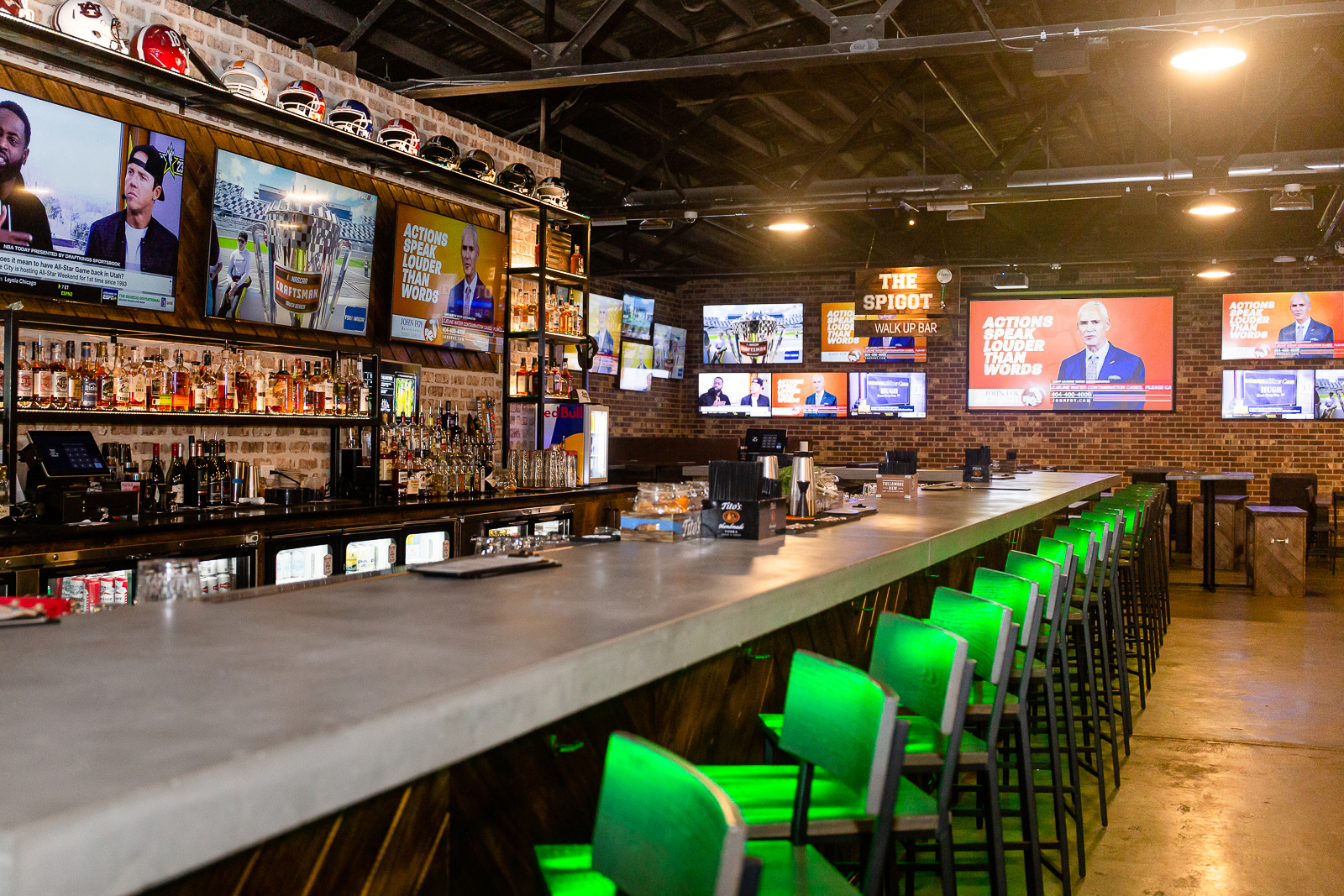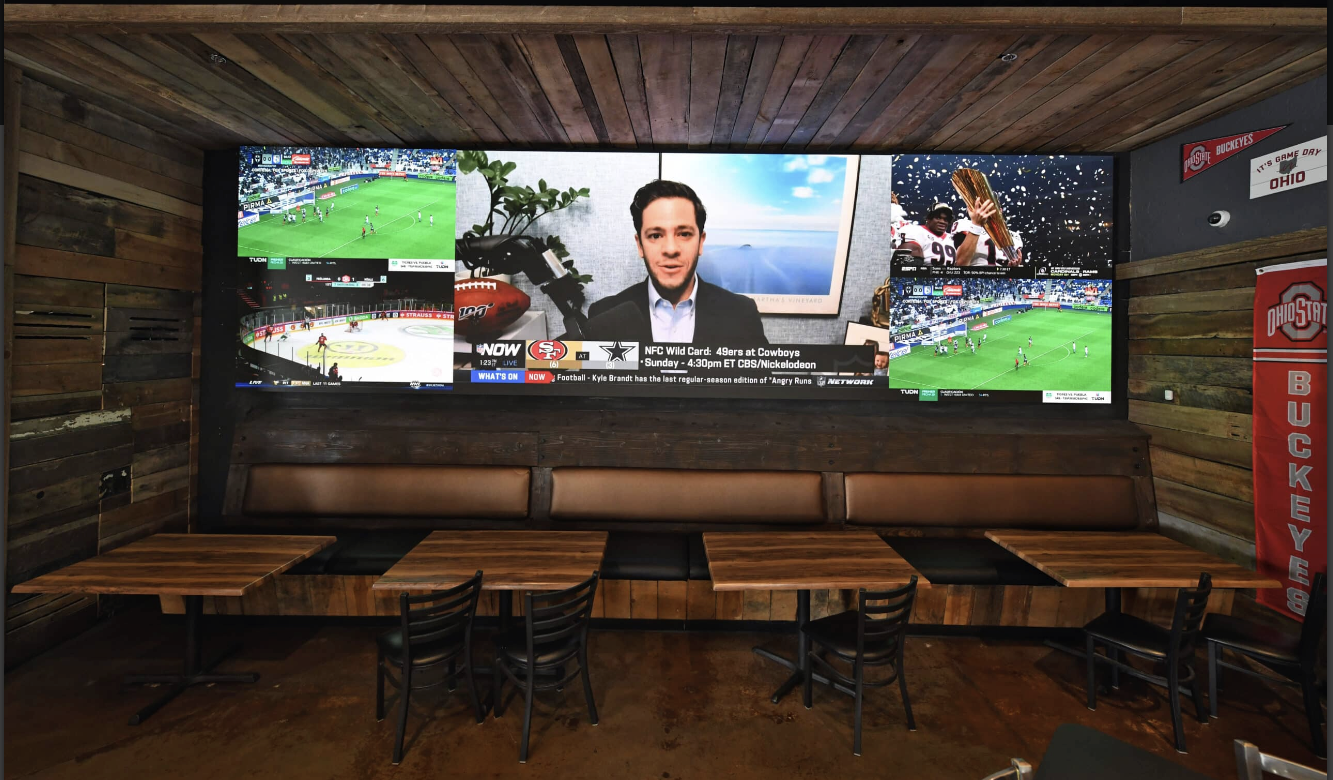Sports Bars Rival Ballparks, Stadiums, Arenas in AV Experience
Sports-themed pubs and restaurants are often seen as better places to watch the game
Story Highlights
In the mid 1960s, Bell Telephone Co. — forerunner to today’s AT&T — came up with a catchy slogan for its long-distance service: “It’s the next best thing to being there.” Today, that could be slogan of the sports bar. Listing cable, satellite, and broadcast sports coverage designed specifically for sports-themed restaurants and bars, online service SportsTV Guide describes sports bars as places where “guests are typically fans who don’t have tickets to the game. However, they would demand an experience that is almost on par with watching the match live in a stadium.”
It’s a tall order but one that an increasingly large number of upper-tier venues vie to fill, using AV technology that’s nearly on a par with that in the trucks at the venues.

Happy’s Sports Lounge in Murfreesboro, TN, features 26 video screens managed by a Key Digital AV-over-IP system.
Big Screens Rule
“In some ways, sport bars are becoming better places to see the game than the stadium or the arena,” observes Brian Elwell, senior consultant, Salas O’Brien, a Dallas-based engineering- and technical-services firm that has designed AV systems for such venues as the Seattle Kraken’s Climate Pledge Arena, the Minnesota Vikings’ US Bank Stadium, and Austin FC’s Q2 Stadium. “It’s the one place you’re going to get every camera angle for every game on television, all of the commentary, and experience it on a screen much bigger than you could ever have at home.”

Salas O’Brien’s Brian Elwell: “It’s the one place you’re going to get every camera angle for every game on television on a screen much bigger than you could ever have at home.”
He cites the 716 Bar in Buffalo, NY, for which Salas O’Brien designed and had installed a 38-ft. video screen and 70 HDTVs around the space. Display placement has become important in the design of these types of facilities, he says, to ensure that virtually every game can be seen from every seat in the house.
“That’s not something that you can get even at the stadium or the arena for just the one game,” he says. “You may be coming to the bar to see a particular game, but, once you’re in a place like this, you’re immersed in sports.”
That said, he adds that the massive central screen is windowed, allowing other events and ticker-type information to share the display with whatever the main game is. “There should be a focus, even when there are a number of other events taking place.”
An Industry Born in a Bar
Broadcast television created the sports bar. On a June evening in 1947, a New York Times reporter noted men squeezing into Hussey’s Bar & Grill on 47th St. and Ninth Ave. in Manhattan an hour before a Brooklyn Dodgers game, angling for seats near the bar’s newly installed 12-in. black-and-white TV set. The crowd reportedly stayed late, too, watching boxing matches while others gathered outside the windows hoping to catch a bit of the action.
Since then, the concept has evolved to one that can rival the experience in guest suites in some stadiums and arenas. In fact, some bars market themselves as essentially less-expensive versions of those elite niches. Others have taken on the accoutrements of specific sports, such as the new 8,500-sq.-ft. Flanker Kitchen & Sports Bar at Las Vegas’s Mandalay Bay resort, near the walkway to Allegiant Stadium (where the 2024 Super Bowl will take place), where an illuminated ceiling offers a nighttime rendering of the city’s Formula 1 track.
“We wanted to do the sports theming in a clever and refined manner rather than putting up sports memorabilia everywhere,” Carver Road Hospitality CEO Sean Christie told the Las Vegas Review-Journal.
Diversity in sports is extending to sports bars, most notably in the form of Jenny Nguyen’s LGBTQ-friendly Sports Bra in Portland, OR, the world’s first sports bar dedicated to showing only women’s sports.
Today, one database estimates that there are more than 18,000 sports bars in the country, defined as pubs and restaurants that promote multiple screens for games and matches, often integrating key sports events into their regular marketing. After watching stadiums and arenas become media and hospitality centers and the rise of the luxury sportsbook in the wake of a change in sports-betting regulations nationally, the neighborhood sports bar is rising to the challenge.
The Big Picture

Logic Integration’s Dylan Cassagnol: ““It’s all about giving everyone everything. Everyone can view [the action] from essentially anywhere in the restaurant or bar.”
He sees the video trend as toward larger LED displays and away from multiple flat screens, each with their own cable boxes, that once characterized the category. This is, in part, because there is often now so much sports to choose from at any one time.
“It’s all about giving everyone everything,” Cassagnol says. “Bars pay that extra dollar with the cable company so that they have NFL Sunday Ticket or NFL RedZone and don’t have to choose. It’s all up there on one large, accessible, strategically placed wall. Everyone can view from essentially anywhere in the restaurant or bar. That has become the model now.”
Streaming and Sound
Streaming, he adds, will make that even easier, replacing multiple cable boxes and remotes with a single computer as the content hub.
“If you’re at a traditional sports bar, which has just a cable subscription, you can’t watch Thursday Night Football because Amazon owns it,” he explains. “With an IP system, we’ll get you a Mac Mini and plug it in as a source, and then you just go to Prime Video, sign in, pull it up, and there you go. There’s the game.”
But it’s the massive video displays, the bigger the better, that Cassagnol says are changing the game for the sports bar.
“That is the big difference maker,” he says. “That and a willingness to spend the extra dollar to give you a better experience. Better audio and visual experience tends to draw a bigger crowd. You create a memorable and differentiated experience. You get those people in the door who want to watch the games, who wanted to go to the game or could have stayed home. This is that middle point where you’re going somewhere and there’s a great viewing experience. You might not be at the game, but you’re around fans, you’re around that atmosphere. You get that experience but without the hassle and expense of going all the way to the game. You’re in this great middle zone.”
Sound Matters
Interestingly, audio is sometimes of secondary importance in sports-bar AV design. The intent is an immersive sort of noise, through which at least a rumble of the main-game commentary is audible (if not necessarily completely intelligible in a room filled with Bud Light–fueled “experts”). That’s achieved by minimizing reflective surfaces in the room and by installing more speakers to get direct sound onto the seating and viewing areas and time-aligning them for various parts of the space (that is, delaying the audio to speakers closest to the screen) and attenuating them as needed near dining areas. That’s not to say, however, that audio doesn’t have nuance in the sports bar.
“The audio for high-end sports bars is largely driven by the room dimensions and acoustics,” explains David Soran, VP, commercial sales, Logic Integration. “On a busy weekend, there is often a ‘home’ team for the bar featured on the main display, with various other games on side panels of the video wall or nearby displays. The main audio source is the ‘home’ game throughout the bar.
If the room has distinct areas, there may be two or three focus games, whose audio will be divided into zones based on the featured game in that section. In this case, if ceiling height allows, a pendant-style speaker is often preferred to keep the audio-coverage pattern over the patrons without a lot of wash into other areas. We prefer to have wireless touch panels for the managers to walk around the seating areas and be able to adjust source selection and volume in different zones. We also prefer at least 8-in. speakers for mains with some subwoofers added for low-end support when the game has a halftime live performance.
“Great audio is necessary for the success of the projects,” he continues, “but there has to be give and take for game-hype volume vs. patron comfort for long stays. Acoustics, aesthetics, sources, and zones are all important conversations to have.”
A Use Case Similar to Venues
Elwell sees sports bars at this level following the same kinds of business use cases as stadiums and arenas themselves: needing to be configured to host as many types of events as possible.
“Just like you don’t build football stadiums mostly for just 16 games a year anymore, a high-end sports bar wants to be full 300 nights a year or more,” he explains. “They’re doing market research to see what the customers are going to want to see on the big screens and market into that. They want to maximize the use of their venue, just like any stadium or arena would. And just like them, sports bars are going to want to focus on a game as an event.”
Ubiquitous and Competitive
Sports bars have come a long way since crowds watched Brooklyn Dodgers games at Hussey’s Bar & Grill in Manhattan in 1947. They offer a way for fans to cheer, jeer, and pontificate in an atmosphere as charged as an arena or stadium, thanks to video and audio systems that take their cues from the real thing. Here are a couple of examples.
Sportsbook Bar & Grill: In the greater Denver area, the locally owned pub offers places for customers to watch sports when they can’t be at the game. Its newest location, in Highlands Ranch, CO, received a full interior remodel, including an AV design that would deliver a similar ambiance to the company’s other locations except on a much grander scale.
Logic Integration installed a nearly 24-ft.-long, 1.5-pixel-pitch Planar TVF Series and a combined 44 Planar Simplicity M Series 55- and 65-in. displays in throughout the facility. A binary media-over-IP system distributes content to the displays, and a mix of full-range pendant and surface-mounted speakers are installed in the main dining area and the outdoor, covered patio.
“We wanted it to have a wow factor,” says Sportsbook Bar & Grill co-owner Judson Dymond. “The idea was for people to walk in and say, ‘Wow! You can’t find this anywhere else.’ No matter where they are in the place, they could still watch the game they want to watch.”
He credits the viewing experience for helping shape the growing popularity of the new location: “The video wall and displays are definitely driving traffic. We opened and were busy right away. We hear lots of positive comments about the video wall and the buzz we’ve received as the place to watch games has been impressive.”
Happy’s Sports Lounge: In Murfreesboro, TN, patrons not only get to watch sports but participate in them, too: the venue’s miniature duckpin bowling and cutting-edge golf simulators combine with a sports-viewing lounge powered by an expansive and flexible AV-over-IP system. Using Crestron control systems and Key Digital encoders and decoders for signal management, Franklin, TN-based Professional Audio Visual Systems (PAVS) not only designed the AV system to operate as seamlessly as possible — allowing patrons to watch, listen, and play without missing a beat — but also designed it for multiple-use applications.
“We had a lot of creative and collaborative-type meetings initially,” says PAVS Managing Partner Mike Richards. “[Happy’s Sports Lounge executives] told me, ‘We would like everything to work cohesively with an intuitive management system for our staff.’ We spent a lot of time talking about physical layout of the various spaces. We discussed sight lines and equipping some of the displays for digital-signage messaging based on where [the displays] were placed. [The Happy’s folks] definitely had a good idea about what they wanted at a high level, but I also talked to them about how to do some branding and some marketing in the space, as they also wanted to have corporate clients in addition to individual patrons.”

